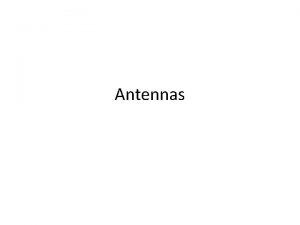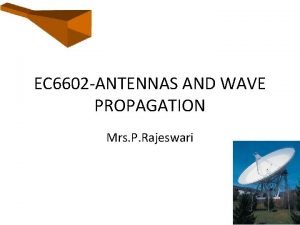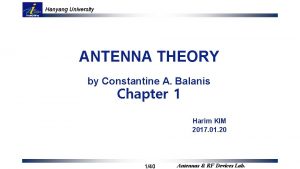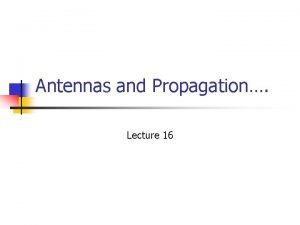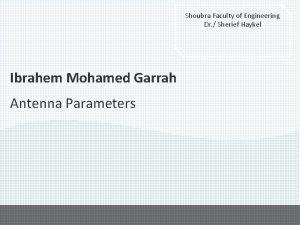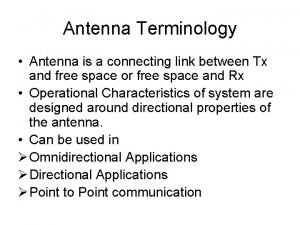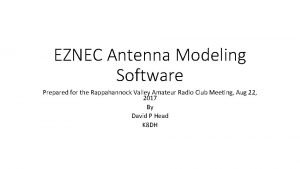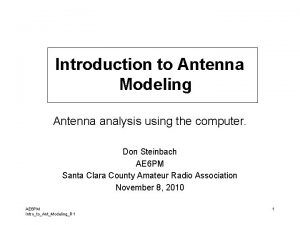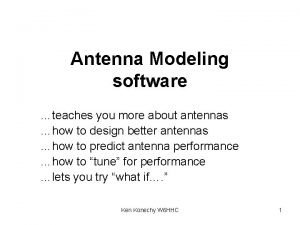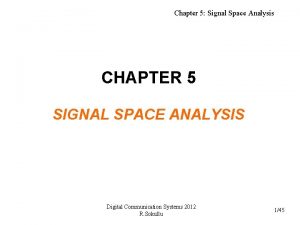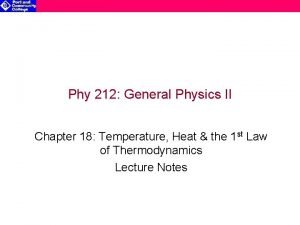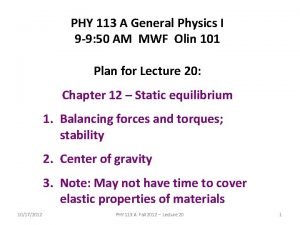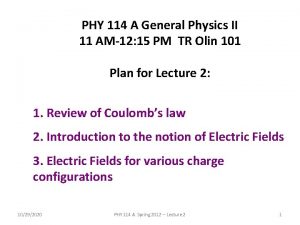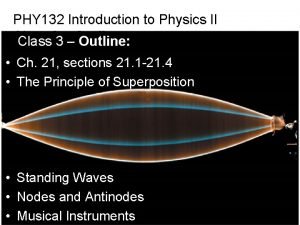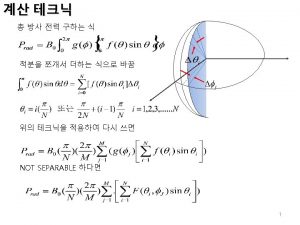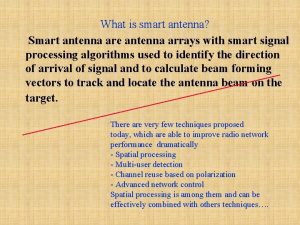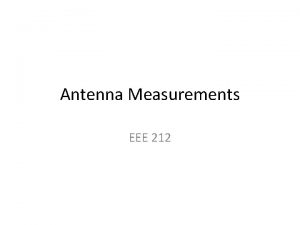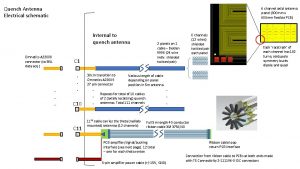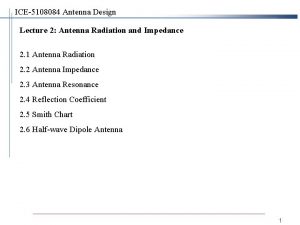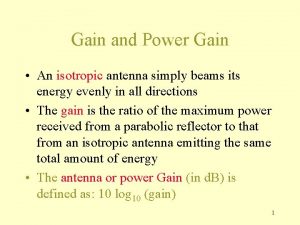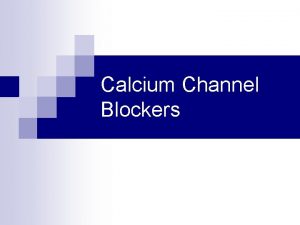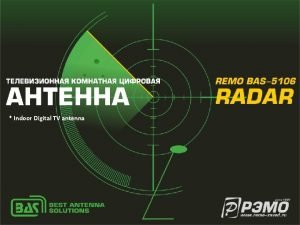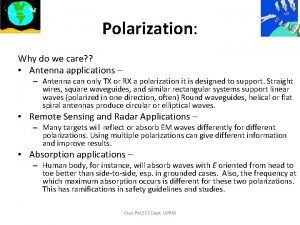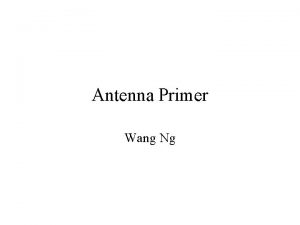Phy Channel Modeling Isotropic Radiation An isotropic antenna























- Slides: 23

Phy Channel Modeling

Isotropic Radiation Ø An isotropic antenna is an antenna that transmits equally in all directions d Ø Law of Conservation of Energy: “Energy can neither be created nor destroyed …” © Tallal Elshabrawy From “Wireless Communications” Edfors, Molisch, Tufvesson

Power Reception by an Isotropic Antenna Power Received by Antenna Ae=ARx Effective Area of Antenna Power Received by Isotropic Antenna From “Wireless Communications” Edfors, Molisch, Tufvesson LP Free-space Path-loss between two isotropic antennas © Tallal Elshabrawy 3

© Tallal Elshabrawy

Directional Radiation l A Directional Antenna: l Transmit gain Gt is a measure of how well an antenna emits radiated energy in a certain direction relative to an isotropic antenna. l Receive gain Gr is a measure of how well the antenna collects radiated energy in a given area relative to an isotropic antenna. Maximum transmit or receive antenna Gain Maximum (Peak) Antenna Gain Main Lobe 3 d. B Beam Width Side Lobes Antenna Pattern for Parabolic (dish-shaped) antenna © Tallal Elshabrawy 5

The Friis Equation l l The received power falls off as the square of the T-R separation distance The received power decays with distance at a rate of 20 d. B/decade Valid for Line of Sight (LOS) satellite communications The Friis free-space model is only valid for values of d in the far field. The far field is defined as the region beyond the far field distance df D is the largest linear dimension of the transmitting antenna aperture © Tallal Elshabrawy Note: df must also satisfy df>>D, df>>λ 6

PR(d) in the Far Field l The Friis equation is not valid at d=0 l PR(d) could be related to a power level PR(d 0) that is measured at a close in distance d 0 that is greater than df © Tallal Elshabrawy 7

In Wireless, Everything is Relative l © Tallal Elshabrawy

Path-Loss Models l l l The most general case of signal reception might consist of a direct path, reflected paths, diffracted paths, and scattered paths (which makes mathematical analysis cumbersome) Path-Loss models are empirical models that are based on fitting curves or analytical expressions that recreate a set of measured data Note: l © Tallal Elshabrawy A given empirical model might only be valid within the environment where the measurements used to estimate such model have been taken 9

Log-Distance Path-Loss Model Theoretical and Measurement-based Propagation suggest that the average received signal power decreases logarithmically with distance PL (d): Average path-loss for an arbitrary separation n : Path-loss exponent © Tallal Elshabrawy 10

Path-Loss Exponent for Different Environments Environment Free-Space Urban area cellular radio Shadowed urban cellular radio Path-Loss Exponent n 2 2. 7 to 3. 5 3 to 5 In building line-of-sight 1. 6 to 1. 8 Obstructed in building 4 to 6 Obstructed in factories 2 to 3 © Tallal Elshabrawy 11

Log-normal Shadowing l Distance between two nodes alone cannot fully explain the signal strength level at the receiver l Shadowing has been introduced as a means to model the variation of signal propagation behavior between two different signal paths assuming the same propagation distance PL (d): Path-loss model for an arbitrary separation d Xσ : Shadowing parameter (zero mean Gaussian distributed random variable in d. B with standard deviation σ also in d. B) © Tallal Elshabrawy 12

Received Power in Path-Loss Models d d 4 3 d d Position Index 1 © Tallal Elshabrawy 2 1 2 3 4 13

Received Power in Path-Loss Models d d 4 3 d d Position Index 1 © Tallal Elshabrawy 2 1 2 3 4 14

Reception Quality d d 4 3 d d Position Index 1 © Tallal Elshabrawy 2 1 2 3 4 γ: Desired received power threshold 15

Indoor Propagation Models l The indoor radio channel differs from the traditional mobile radio channel in the following aspects l Much smaller distances l Much greater variability of the environment for a much smaller range of T-R separation distances l Difficult to ensure far-field radiation l Propagation within buildings is strongly influenced by specific features such as l l l Building layout Construction materials Building type Open/Closed doors Locations of antennas © Tallal Elshabrawy 16

Example of Reflection in Indoor Models All Ray Paths for Lo. S, Single and Double Reflections between Tx 1 and RX Tx 1 Rx © Tallal Elshabrawy Tx 2 17

Log-Distance Pathloss Model l The lognormal shadowing model has been shown to be applicable in indoor environments © Tallal Elshabrawy 18

Attenuation Factor Model l This was described by Seidel S. Y. It is an in-building propagation model that includes l Effect of building type l Variations caused by obstacles l l l n. SF represents the path-loss exponent for the same floor measurements FAF represents the floor attenuation factor PAF represents the partition attenuation factor for a specific obstruction encountered by a ray drawn between the transmitter and receiver © Tallal Elshabrawy 19

Attenuation Factor Model l FAF may be replaced by an exponent that accounts for the effects of multiple floor separation l n. MF represents the path-loss exponent based on measurements through multiple floors © Tallal Elshabrawy 20

Partition Losses (Same Floor) “Wireless Communications: Principles and Practice 2 nd Edition”, T. S. Rappaport, Prentice Hall, 2001 © Tallal Elshabrawy 21

Partition Losses between Floors “Wireless Communications: Principles and Practice 2 nd Edition”, T. S. Rappaport, Prentice Hall, 2001 © Tallal Elshabrawy 22

THAT’S ALL I GOT TO SAY ABOUT THAT © Tallal Elshabrawy 23
 Balun is a device
Balun is a device Radiation intensity of antenna
Radiation intensity of antenna Antenna magus
Antenna magus Pattern solid angle
Pattern solid angle Radiation mechanism of two wire antenna
Radiation mechanism of two wire antenna Line of sight propagation
Line of sight propagation Radiation intensity of antenna
Radiation intensity of antenna Radiation intensity of antenna
Radiation intensity of antenna Eznec free download
Eznec free download Antenna modeling for beginners
Antenna modeling for beginners Antenna modeling software
Antenna modeling software Model and role modeling theory
Model and role modeling theory Relational vs dimensional data modeling
Relational vs dimensional data modeling Types of multi channel retailing
Types of multi channel retailing Jfet self bias configuration
Jfet self bias configuration Conversion of continuous awgn channel to vector channel
Conversion of continuous awgn channel to vector channel Phy113
Phy113 Phy tgen
Phy tgen Physics heat and temperature
Physics heat and temperature 2012 phy
2012 phy Phy
Phy Accommodation eye
Accommodation eye Great orthogonality theorem
Great orthogonality theorem Phy 132
Phy 132
